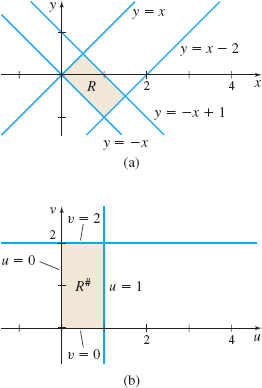EXAMPLE 3Using a Jacobian in a Double Integral
Find ∬
where R is the region enclosed by y=x, \ y=x-2, \ y=-x, and \ y=-x+1 .
Solution The integrand (x+y)\sin (x-y) suggests changing the variables to u=x+y and v=x-y. Then the lines x-y=0, \ x-y=2, \ x+y=0, and \ x+y=1 in the xy-plane define the region R, and the lines v=0, v=2, u=0, and u=1 in the uv-plane define the region R^{\#}. See Figure 64. We solve the system of equations \left\{ \begin{array}{l} u=x+y \\[3pt] v=x-y \end{array} \right. for x and y, and obtain \begin{equation*} x=\dfrac{u+v}{2}\qquad y=\dfrac{u-v}{2} \end{equation*}
Using these equations, the Jacobian is \begin{equation*} \dfrac{\partial (x,y)}{\partial (u,v)}=\left\vert \begin{array}{l@{\quad}r} \dfrac{1}{2} & \dfrac{1}{2} \\[9pt] \dfrac{1}{2} & -\dfrac{1}{2} \end{array} \right\vert =-\dfrac{1}{4}-\dfrac{1}{4}=-\dfrac{1}{2} \end{equation*}
The integral under this change of variables becomes \begin{eqnarray*} \iint\limits_{\kern-3ptR}(x+y)\sin (x-y)\,d\!A& =&\iint\limits_{\kern-3ptR^{\#}}u\sin v\cdot \left\vert -\dfrac{1}{2}\right\vert \,du\,dv=\dfrac{1}{2}\int_{0}^{1} \int_{0}^{2}u\sin v\,dv\,du \notag \\ & =&\dfrac{1}{2}\int_{0}^{1}\big[u(-\cos v)\big] _{0}^{2}\,du= \dfrac{1}{2}(1-\cos 2)\int_{0}^{1}u\,du \notag \\[4.5pt] & =&\dfrac{1}{4}(1-\cos 2) \end{eqnarray*}
